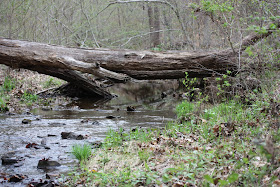Tuesday, April 19, 2011
Stream Report: Long Island Creek -- Nemourids and Spiny Crawlers
Let's start with the "prettiest" insect I found this morning: this Perlodid stonefly, genus Isoperla. The dark wing pads are a sure sign that it's getting ready to hatch, so it's much further along than the Isoperlas I've been finding in other streams. (Is that because I was in Fluvanna county, further away from the mountains?) Still, I must apologize for this and all of my photos today: I had very poor light conditions, so none of my photos is as "sharp" as I'd like it to be. One other shot of this Perlodid. (All of the photos look a little bit better if you click on them to enlarge them.
In addition to this lonely Perlodid, I found a number of Eccoptura common stoneflies (Perlids), one Leuctridae (Rolled-winged stonefly -- very small), a couple of flatheaded mayflies (genus Maccaffertium), a few Uenoid case-maker caddisflies (not yet pupating here), some netspinners (genus Diplectrona -- the "intolerant" one), one freeliving caddisfly (gray body), and one "trumpetnet" caddisfly. (Oh, yes: and some hellgrammites, black flies, and crane fly larvae.)
But the dominant taxa were Nemourid stoneflies (genus Amphinemura), and spiny crawlers -- the insects that tend to take over our streams in the spring. I picked up a lot of Nemourids. They were still on the small side, but for the first time this year I saw a Nemourid that I could tell by its overall shape was a Nemourid. Here's the best picture I managed (and I'm sorry that I apparently broke off one of its tails!)
Note the triangular shape of the head; the large, square-shaped pronotum; the square shape of the top of the primary wingpads; and the sloping shape to the wing pads as a whole -- they kind of curve in then flare back out to the tips at the end. Also characteristic -- the light line that runs from the head to the ends of the wing pads, and the "T" shape of that line on the head. And, note the color: uniformly dark brown.
If you see enough of these in the spring, you can pick them out in your tray by picking up on these traits. Of course the other feature to look for -- the "cervical" gills that stick out from both sides of the neck. No matter how small your nymph might be, the gills can almost always be seen by using a loupe --sometimes with the naked eye. Look at the size of the gills on this tiny nymph. (Please click on the photo to enlarge it.)
Almost all of the Nemourids I found were crawling on the bottoms of rocks; a few were in leaf packs.
All of the spiny crawlers were, again, picking their way through the moss on the rocks that were covered with water. These are the taxa -- Nemourid stones (genus Amphinemura) and spiny crawler mayflies (genus Ephemerella)-- that will dominate samples in a lot of our streams throughout April and May. (Below, Long Island Creek in the spring.)





No comments:
Post a Comment